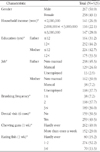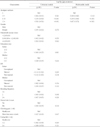Abstract
Objectives
Dental amalgam is a widely used filling material for oral cavity. The released mercury vapor from amalgam could have systemic adverse effects potentially. The purpose of this study is to evaluate the relationship between dental amalgam and urinary mercury levels in children during a 6-month timespan.
Methods
A total of 525 elementary school children participated in this study. Oral examination was carried out from one dentist. Urine samples collected at baseline and at 6 month were analyzed for mercury and creatinine excretion. Additionally, general characteristics of subjects were surveyed by a questionnaire. The statistical analysis was performed using the SPSS 18.0.
Figures and Tables
 | Fig. 1Urinary mercury levels according to number of amalgam surface at 6 month after adjusted of baseline mercury level. |
References
1. World Health Organization. Elemental mercury and inorganic mercury compounds: human health aspects. 2003. Geneva: World Health Organization;4–5.
2. Faculty Council of Korean Dental Material. Dental materials. 2011. 6th ed. Seoul: Koonja publishing Inc;220–222.
3. Clarkson TW, Magos L. The toxicology of mercury and its chemical compounds. Crit Rev Toxicol. 2006. 36:609–662.

5. Johnsson C, Schütz A, Sällsten G. Impact of consumption of freshwater fish on mercury levels in hair, blood, urine, and alveolar air. J Toxicol Environ Health A. 2005. 68:129–140.

6. Zolfaghari G, Esmaili-Sari A, Ghasempouri SM, Faghihzadeh S. Evaluation of environmental and occupational exposure to mercury among Iranian dentists. Sci Total Environ. 2007. 381:59–67.

7. Ritchie KA, Burke FJ, Gilmour WH, Macdonald EB, Dale IM, Hamilton RM, et al. Mercury vapour levels in dental practices and body mercury levels of dentists and controls. Br Dent J. 2004. 197:625–632.

8. Ngim CH, Foo SC, Boey KW, Jeyaratnam J. Chronic neurobehavioural effects of elemental mercury in dentists. Br J Ind Med. 1992. 49:782–790.

9. Counter SA, Buchanan LH. Mercury exposure in children: a review. Toxicol Appl Pharmacol. 2004. 198:209–230.

10. Bellinger DC, Trachtenberg F, Barregard L, Tavares M, Cernichiari E, Daniel D, et al. Neuropsychological and renal effects of dental amalgam in children: a randomized clinical trial. JAMA. 2006. 295:1775–1783.

11. DeRouen TA, Martin MD, Leroux BG, Townes BD, Woods JS, Leitão J, et al. Neurobehavioral effects of dental amalgam in children: a randomized clinical trial. JAMA. 2006. 295:1784–1792.

12. Thygesen LC, Flachs EM, Hanehøj K, Kjuus H, Juel K. Hospital admissions for neurological and renal diseases among dentists and dental assistants occupationally exposed to mercury. Occup Environ Med. 2011. 68:895–901.

13. Hilt B, Svendsen K, Syversen T, Aas O, Qvenild T, Sletvold H, et al. Occurrence of cognitive symptoms in dental assistants with previous occupational exposure to metallic mercury. Neurotoxicology. 2009. 30:1202–1206.

14. Wright B, Pearce H, Allgar V, Miles J, Whitton C, Leon I, et al. A comparison of urinary mercury between children with autism spectrum disorders and control children. . PLoS One. 2012. 7:e29547. DOI: 10.1317/journal.pone.0029547.

15. Song KB, Lee YE, Jeong SH, Kim HY, Kwon HK. Mercury distribution and concentration in rats fed powdered dental amalgam. Arch Oral Biol. 2002. 47:307–313.

16. Abraham JE, Svare CW, Frank CW. The effect of dental amalgam restorations on blood mercury levels. J Dent Res. 1984. 63:71–73.

17. Khordi-Mood M, Sarraf-Shirazi AR, Balali-Mood M. Urinary mercury excretion following amalgam filling in children. J Toxicol Clin Toxicol. 2001. 39:701–705.

18. Kim DE, Song KB. Mercury accumulation in human tissues from restored dental amalgam. J Korean Acad Oral Health. 1998. 22:69–80.
19. Dye BA, Schober SE, Dillon CF, Jones RL, Fryar C, McDowell M, et al. Urinary mercury concentrations associated with dental restorations in adult women aged 16-49 years: United States, 1999-2000. Occup Environ Med. 2005. 62:368–375.

20. Kingman A, Albertini T, Brown LJ. Mercury concentrations in urine and whole blood associated with amalgam exposure in a US military population. J Dent Res. 1998. 77:461–471.

21. Ministry of health and welfare. 2010 Korean national oral health survey: II. Survey Report. 2010. Seoul: Ministry of Health and Welfare;191.
22. Oh AE, Choi YH, Jin HJ, Park JH, Kim YS, Keun HJ, et al. Current status of the types of dental filling and preventive materials among children in mixed dentition. J Acad Ind Technol. 2010. 11:1483–1491.

23. Maserejian NN, Trachtenberg FL, Assmann SF, Barregard L. Dental amalgam exposure and urinary mercury levels in children: the New England Children's Amalgam Trial. Environ Health Perspect. 2008. 116:256–262.

24. Geier DA, Carmody T, Kern JK, King PG, Geier MR. A significant relationship between mercury exposure from dental amalgams and urinary porphyrins: a further assessment of the Casa Pia children's dental amalgam trial. Biometals. 2011. 24:215–224.

25. Suzuki T, Hongo T, Abe T, Matsuo N, Inoue N. Urinary mercury level in Japanese school children: influence of dental amalgam fillings and fish eating habits. Sci Total Environ. 1993. 136:213–227.

26. Levy M, Schwartz S, Dijak M, Weber JP, Tardif R, Rouah F. Childhood urine mercury excretion: dental amalgam and fish consumption as exposure factors. Environ Res. 2004. 94:283–290.

27. Dunn JE, Trachtenberg FL, Barregard L, Bellinger D, McKinlay S. Scalp hair and urine mercury content of children in the Northeast United States: the New England Children's Amalgam Trial. Environ Res. 2008. 107:79–88.

28. Woods JS, Martin MD, Leroux BG, DeRouen TA, Leitão JG, Bernardo MF, et al. The contribution of dental amalgam to urinary mercury excretion in children. Environ Health Perspect. 2007. 115:1527–1531.

29. Kang SI, Lee HC. The effects of amalgam restorations on blood mercury levels among the amalgam recipients dental personnel. Inje Med J. 1999. 20:503–512.




 PDF
PDF ePub
ePub Citation
Citation Print
Print





 XML Download
XML Download